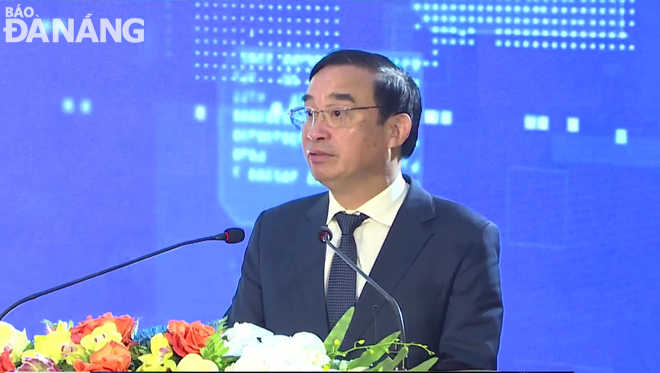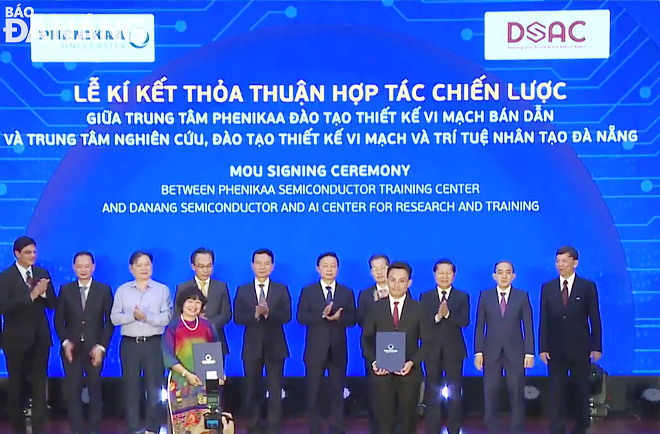Da Nang rolls out solutions to promote semiconductor development
Da Nang is focusing on 3 groups of solutions to promote the development of the semiconductor industry.
The information was released by municipal People’s Committee Chairman Le Trung Chinh at an international conference on Vietnamese semiconductor human resources in the global supply chain held in Ha Noi on Saturday.
 |
| Chairman of the Da Nang People's Committee Le Trung Chinh delivering his speech at the conference. Photo: M.Q |
According to Chairman Chinh, Da Nang has identified hi-tech, including the microchip, semiconductor and artificial intelligence (AI) industries, as an important part of the five breakthrough industry groups creating momentum for the city’s rapid and sustainable development.
Also, Da Nang has prioritised attracting investment and developing the abovementioned fields in a methodical and long-term manner.
Therefore, since the fourth quarter of 2023, the city has drastically and synchronously taken many important steps with the focus on developing semiconductor human resources associated with AI.
In particular, the city hosted a workshop to seek solutions to develop human resources to serve the semiconductor industry on October 10, 2023.
Besides, a delegation of local officials conducted business trips to the U.S. and Taiwan (China) in November 2023 and February 2024 respectively to work with leading corporations on IC and semiconductor design such as Synopsys, Nvidia, Marvell, Qualcomm, and Intel.
Within the framework of the APEC 2023 in the U.S., the People's Committee of Da Nang signed a Memorandum of Understanding with the Synopsys Corporation to boost cooperation in the semiconductor field.
Also, the Da Nang Semiconductor and Artificial Intelligence Center for Research and Training (DSAC) under the Department of Information and Communications was established and went into operation on January 26, 2024.
Recently, many leaders of hi-tech corporations have positively evaluated the city's potential and investment opportunities in IC design and artificial intelligence (AI), as well as conducted surveys about the investment environment and prepare conditions for cooperation in infrastructure development, and human resource training, in the city.
According to the latest statistics, there are about 10 IC design enterprises in the city such as Synopsys, Uniquify, Savarti, Renesas, Synapse, Fptsemi and Viettel CNC with a total of about 550 engineers trained from the University of Science and Technology and other universities in the city. The city's IC design human resources account for nearly 10% of the country’s total.
Da Nang sets a target of training at least 5,000 engineers in the IC and semiconductor fields by 2030.
Currently, the city is building a project on developing semiconductor and microchips which is expected to be issued in mid-2024. This project is considered an important basis for the city to implement tasks and solutions, and build specific support and attraction policies to foster the development of the IC and semiconductor industry in Da Nang, thereby contributing to facilitate the city to participate in the global value chain of semiconductor and future technology.
In the overall set of proposed policies and solutions, Da Nang concentrates on three groups of solutions: infrastructure; human Resources; and preferential policies and investment incentives.
Specifically, international fiber optic network; and electricity, transportation, and logistics infrastructure; at centralised Information Technology Parks, and local software parks fully meet the requirements of investors in microchips, semiconductors, and AI.
Da Nang has a High-Tech Park and three centralised information technology parks that have been recognised by the Prime Minister. Meanwhile, the Software Park No. 2 with a floor area of more than 90,000 square meters, meeting more than 6,000 employees, will be put into use in late 2024. At the same time, the city is preparing a suitable land fund as well as investing in 3 new information technology parks.
Regarding human resources, Da Nang has 37 training establishments related to the information technology industry and industries closely related to the semiconductor field. Every year, about 5,700 students majoring information technology, and other industries related to microchips and semiconductors (such as electronics and telecommunications, mechatronics, automation...) graduate from local universities.
 |
| Representatives of DSAC and the Phenikaa Semiconductor Training Center (PSTC) at the signing ceremony for a Memorandum of Understanding. Photo: M.Q |
To date, three universities in Da Nang have announced new enrollment targets for IC design engineers from August 2024 with nearly 200 targets/year.
On March 23, 2024, the city successfully launched semiconductor and microchip training programmes, and opened a training course on semiconductor to 25 lecturers selected from universities citywide.
At the same time, city-based universities have closely cooperated with reputable international partners from the U.S., South Korea and Taiwan to improve the quality and quantity of training according to international standards in the semiconductor and AI fields.
Moreover, the city has already advised the national government to submit to the National Assembly a draft resolution amending and supplementing Resolution No. 119/2020/QH14 dated June 19, 2020 on piloting the urban government model and a number of specific political mechanisms to develop Da Nang.
Notably, included in the draft resolution are outstanding preferential policies in the field of semiconductor and AI such as corporate and personal income tax exemption; support policies for semiconductor human resource training; policies to attract experts and scientists; policies to support the cost of purchasing supporting equipment for businesses; and policies on direct leasing of information infrastructure assets without going through auction, and on procurement of specific equipment from strategic partners in the field of semiconductor and AI.
Within the framework of the conference, DSAC, representing an alliance of five key universities in Da Nang in human resources education for the semiconductor industry, signed a cooperation agreement with the Phenikaa Semiconductor Training Center (PSTC).
Accordingly, the two sides will establish the Semiconductor Research and Human Resources Training Alliance (VASA).
The VASA Alliance will pay attention to helping leaners practical skills according to market needs in important areas of the semiconductor industry: circuit design, packaging, and testing, as well as maximise the ability to apply learned knowledge to real work.
It sets a goal of training 8,000 chip designers with international certification and 12,000 high-level engineers and technicians working in packaging and testing factories.
Reporting by M.QUE - Translating by M.DUNG